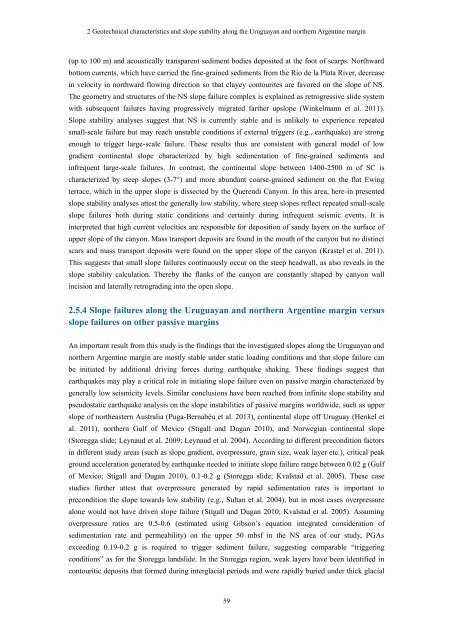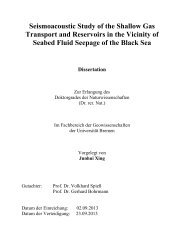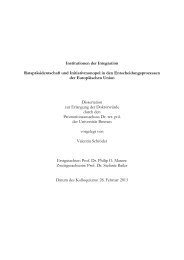Slope stability along active and passive continental margins ... - E-LIB
Slope stability along active and passive continental margins ... - E-LIB
Slope stability along active and passive continental margins ... - E-LIB
Create successful ePaper yourself
Turn your PDF publications into a flip-book with our unique Google optimized e-Paper software.
2 Geotechnical characteristics <strong>and</strong> slope <strong>stability</strong> <strong>along</strong> the Uruguayan <strong>and</strong> northern Argentine margin<br />
(up to 100 m) <strong>and</strong> acoustically transparent sediment bodies deposited at the foot of scarps. Northward<br />
bottom currents, which have carried the fine-grained sediments from the Rio de la Plata River, decrease<br />
in velocity in northward flowing direction so that clayey contourites are favored on the slope of NS.<br />
The geometry <strong>and</strong> structures of the NS slope failure complex is explained as retrogressive slide system<br />
with subsequent failures having progressively migrated farther upslope (Winkelmann et al. 2011).<br />
<strong>Slope</strong> <strong>stability</strong> analyses suggest that NS is currently stable <strong>and</strong> is unlikely to experience repeated<br />
small-scale failure but may reach unstable conditions if external triggers (e.g., earthquake) are strong<br />
enough to trigger large-scale failure. These results thus are consistent with general model of low<br />
gradient <strong>continental</strong> slope characterized by high sedimentation of fine-grained sediments <strong>and</strong><br />
infrequent large-scale failures. In contrast, the <strong>continental</strong> slope between 1400-2500 m of SC is<br />
characterized by steep slopes (3-7°) <strong>and</strong> more abundant coarse-grained sediment on the flat Ewing<br />
terrace, which in the upper slope is dissected by the Querendi Canyon. In this area, here-in presented<br />
slope <strong>stability</strong> analyses attest the generally low <strong>stability</strong>, where steep slopes reflect repeated small-scale<br />
slope failures both during static conditions <strong>and</strong> certainly during infrequent seismic events. It is<br />
interpreted that high current velocities are responsible for deposition of s<strong>and</strong>y layers on the surface of<br />
upper slope of the canyon. Mass transport deposits are found in the mouth of the canyon but no distinct<br />
scars <strong>and</strong> mass transport deposits were found on the upper slope of the canyon (Krastel et al. 2011).<br />
This suggests that small slope failures continuously occur on the steep headwall, as also reveals in the<br />
slope <strong>stability</strong> calculation. Thereby the flanks of the canyon are constantly shaped by canyon wall<br />
incision <strong>and</strong> laterally retrograding into the open slope.<br />
2.5.4 <strong>Slope</strong> failures <strong>along</strong> the Uruguayan <strong>and</strong> northern Argentine margin versus<br />
slope failures on other <strong>passive</strong> <strong>margins</strong><br />
An important result from this study is the findings that the investigated slopes <strong>along</strong> the Uruguayan <strong>and</strong><br />
northern Argentine margin are mostly stable under static loading conditions <strong>and</strong> that slope failure can<br />
be initiated by additional driving forces during earthquake shaking. These findings suggest that<br />
earthquakes may play a critical role in initiating slope failure even on <strong>passive</strong> margin characterized by<br />
generally low seismicity levels. Similar conclusions have been reached from infinite slope <strong>stability</strong> <strong>and</strong><br />
pseudostatic earthquake analysis on the slope instabilities of <strong>passive</strong> <strong>margins</strong> worldwide, such as upper<br />
slope of northeastern Australia (Puga-Bernabéu et al. 2013), <strong>continental</strong> slope off Uruguay (Henkel et<br />
al. 2011), northern Gulf of Mexico (Stigall <strong>and</strong> Dugan 2010), <strong>and</strong> Norwegian <strong>continental</strong> slope<br />
(Storegga slide; Leynaud et al. 2009; Leynaud et al. 2004). According to different precondition factors<br />
in different study areas (such as slope gradient, overpressure, grain size, weak layer etc.), critical peak<br />
ground acceleration generated by earthquake needed to initiate slope failure range between 0.02 g (Gulf<br />
of Mexico; Stigall <strong>and</strong> Dugan 2010), 0.1-0.2 g (Storegga slide; Kvalstad et al. 2005). These case<br />
studies further attest that overpressure generated by rapid sedimentation rates is important to<br />
precondition the slope towards low <strong>stability</strong> (e.g., Sultan et al. 2004), but in most cases overpressure<br />
alone would not have driven slope failure (Stigall <strong>and</strong> Dugan 2010; Kvalstad et al. 2005). Assuming<br />
overpressure ratios are 0.5-0.6 (estimated using Gibson’s equation integrated consideration of<br />
sedimentation rate <strong>and</strong> permeability) on the upper 50 mbsf in the NS area of our study, PGAs<br />
exceeding 0.19-0.2 g is required to trigger sediment failure, suggesting comparable “triggering<br />
conditions” as for the Storegga l<strong>and</strong>slide. In the Storegga region, weak layers have been identified in<br />
contouritic deposits that formed during interglacial periods <strong>and</strong> were rapidly buried under thick glacial<br />
59
















